HTC One and Samsung Galaxy S 4 Google Play edition Review - Nearly Nexus
by Brian Klug on June 26, 2013 1:00 PM EST- Posted in
- Smartphones
- Android
- Mobile
- google play
- Android 4.2
This wouldn't be a proper device review without a section on performance on battery life. Performance is particularly interesting since this is the first time we can take a look at direct comparisons between the same hardware running the stock AOSP interface, and the OEM's skinned platform with all of its features. In theory there shouldn't be that big of a difference since the majority of the platform performance is governed by the kernel, background tasks, obviously silicon and how much memory the base platform occupies. In practice the results are a bit more interesting, though we are comparing the HTC One which is 4.1.2 at present against 4.2.2.
Performance
The first look at performance is our usual assortment of CPU performance benchmarks. Android remains difficult to benchmark in a meaningful manner that tracks well with subjective performance but is getting better. We're using a mix of browser based tests, alongside Java and Native apps (AndEBench, Vellamo).
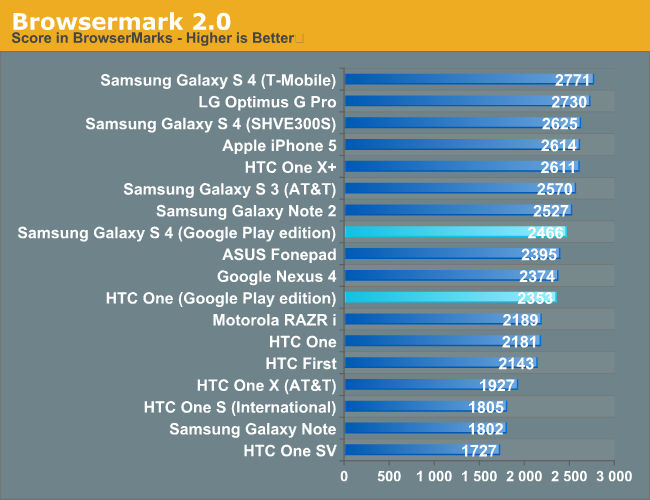


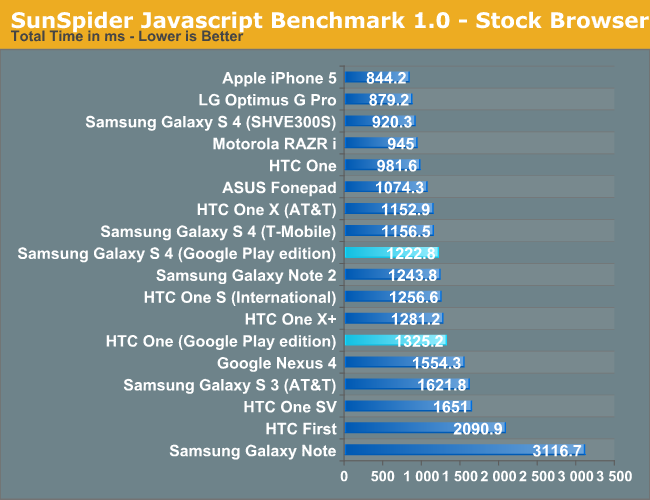
We're using the stock browser for these tests, which means the browser that gets platform optimizations from OEMs through the SoC vendors. For example Samsung builds their own browser, LG and HTC likewise make their own with customizations and use the optimized JavaScript V8 libraries from Qualcomm or whatever silicon vendor whenever possible. On the HTC One and SGS4 GPe versions there's no stock browser per-se beyond Chrome (stable) which remains slower through some these tests than the stock, OEM-built counterpart. As a result the HTC One and SGS4 trade places back and forth with the stock and GPe version each leading in some tests, but not others.

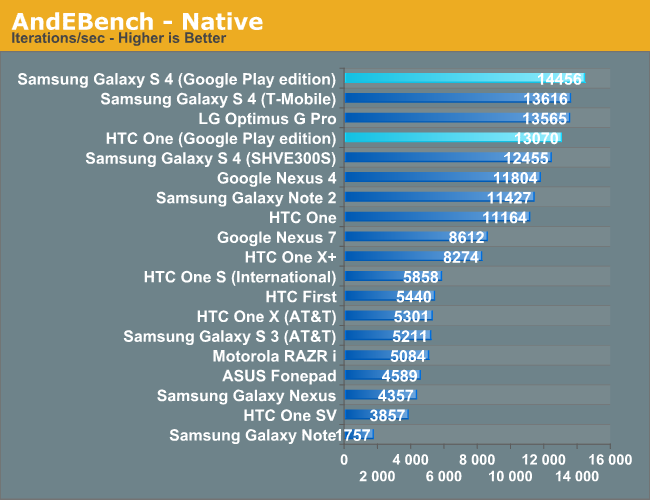
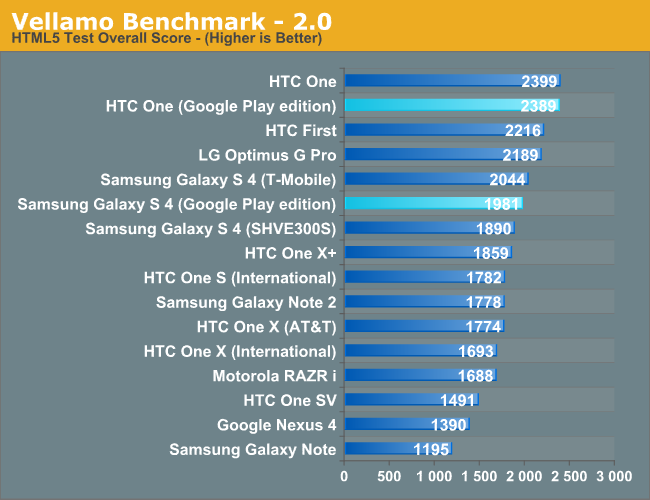
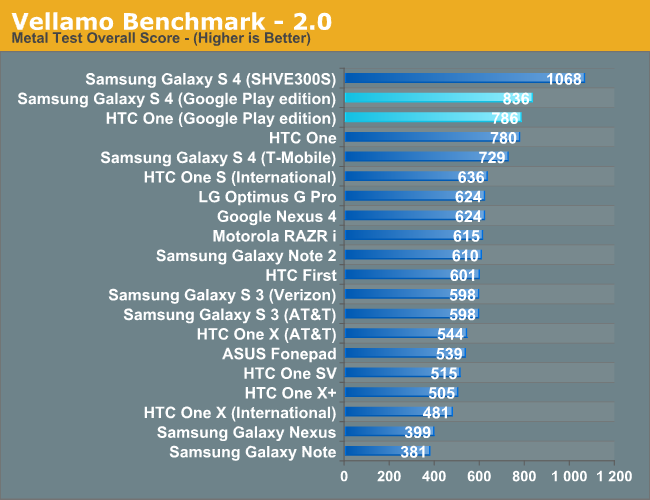
AndEBench rewards the HTC One GPe with a nice lead over its 4.1.2 counterpart, meanwhile the SGS4 also shows a bit of improvement over its stock version.
In Vellamo HTML5 we see both GPe versions of the phones move south of their stock counterparts, again likely due to the not as optimized stock WebView. In the metal test however both get a small boost. In the bits of the platform that we can test, it seems as though having a lighter weight software payload running on the device does grant some performance advantages. Subjectively as I noted before the GPe versions feel speedier.
3DMark for Android features the Ice Storm benchmark and uses OpenGL ES 2.0. Ice Storm is divided into two graphics tests and a physics test. The first graphics test is geometry heavy while the second test is more pixel shader intensive. The physics test, as you might guess, is CPU bound and multithreaded. The overall score takes into account both graphics and physics tests. The benchmark is rendered to an offscreen buffer at 720p/1080p and then scaled up to the native resolution of the device being tested. This is a very similar approach we've seen by game developers to avoid rendering at native resolution on some of the ultra high resolution tablets. The beauty of 3DMark's approach here is the fact that all results are comparable, regardless of a device's native resolution. The downside is we don't get a good idea of how some of the ultra high resolution tablets would behave with these workloads running at their native (> 1080p) resolutions.
For these benchmarks we stuck with the default presets (720p, normal quality).
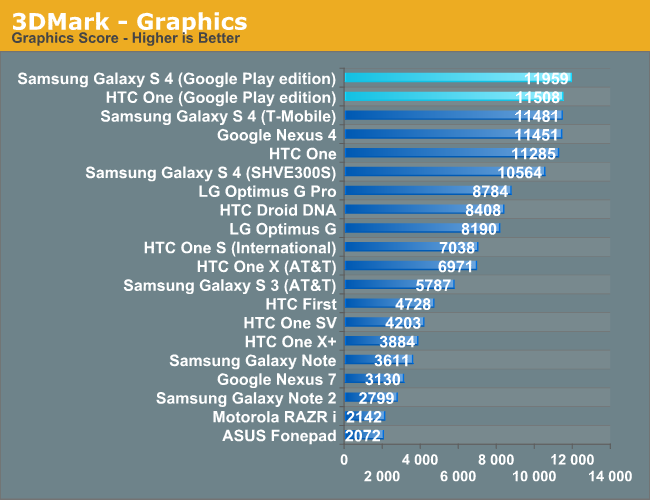

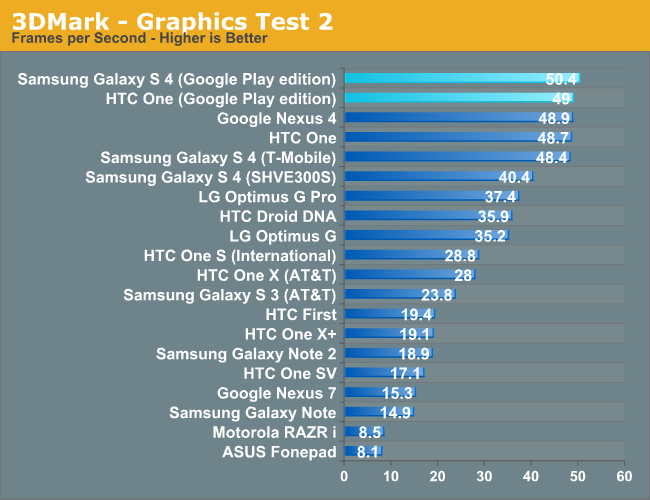
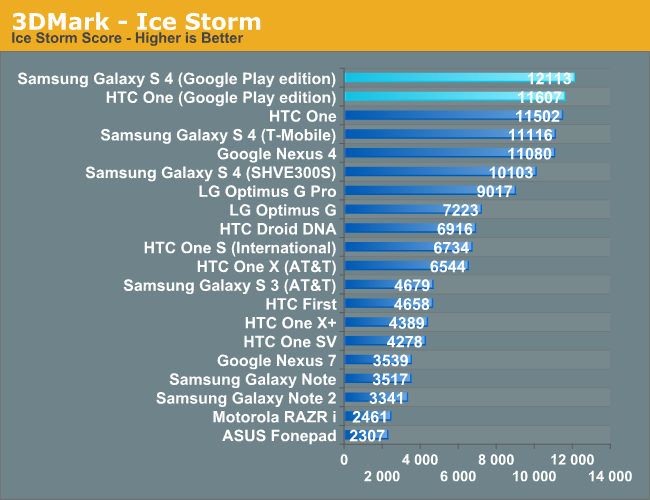
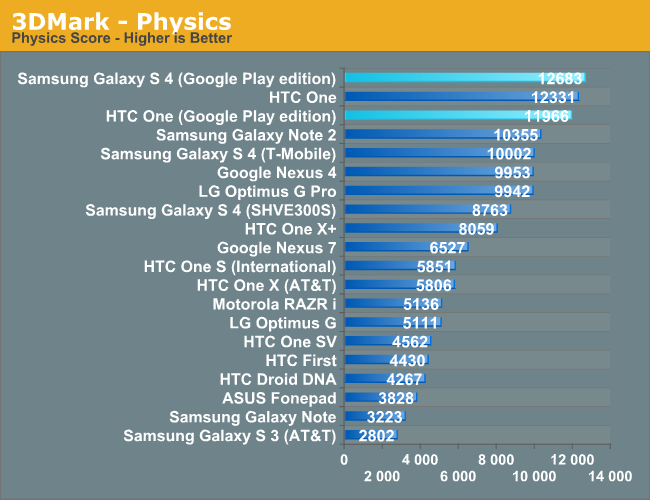
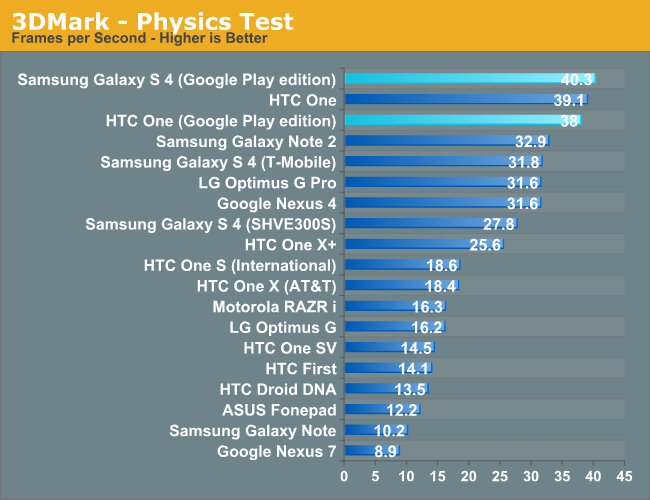
The GPe devices perform favorably in 3DMark for Android, with the SGS4 GPe posting a small but notable lead over its stock counterpart. It's possible there's a driver update lingering in here that's responsible for the small uptick in performance. HTC One sees a boost in the 3D related tests, but doesn't move much in the CPU-focused Physics test.
Up next is GFXBench (formerly GLBenchmark), which is a regular staple in our tests for evaluating 3D performance.
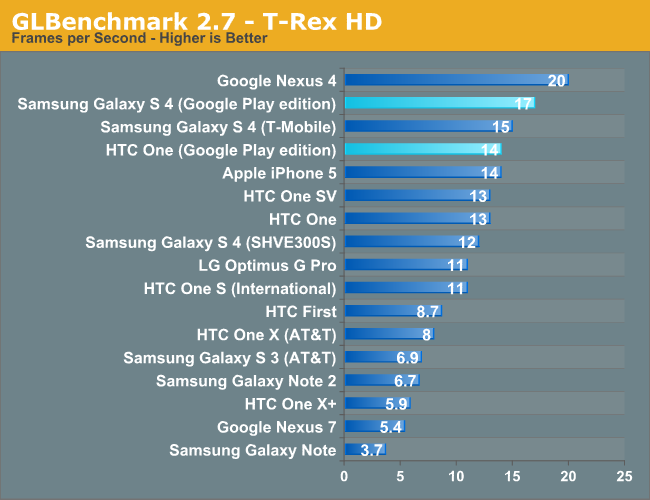
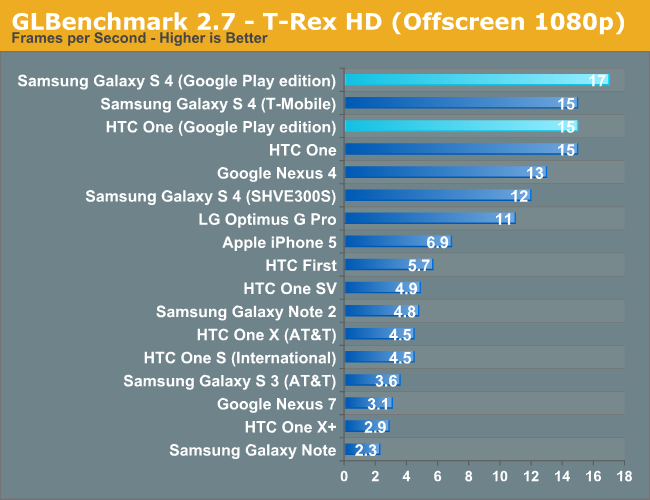
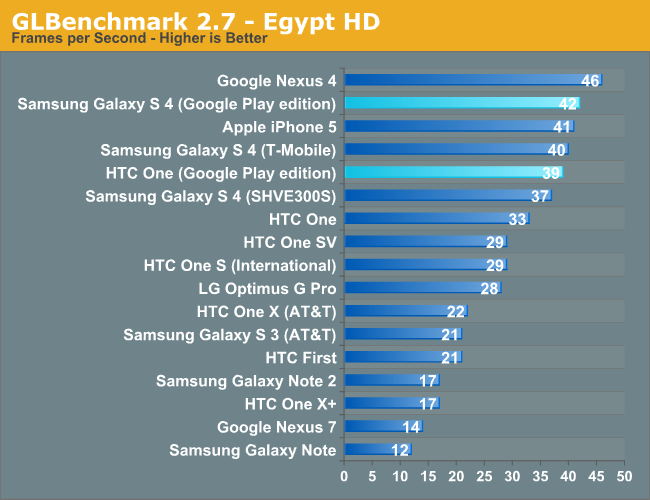


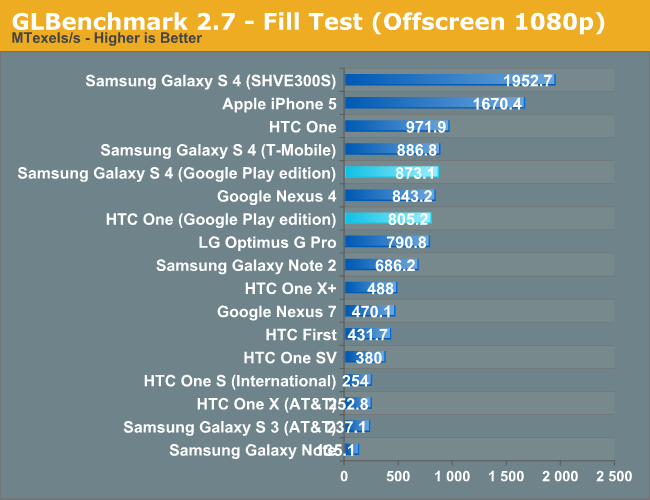
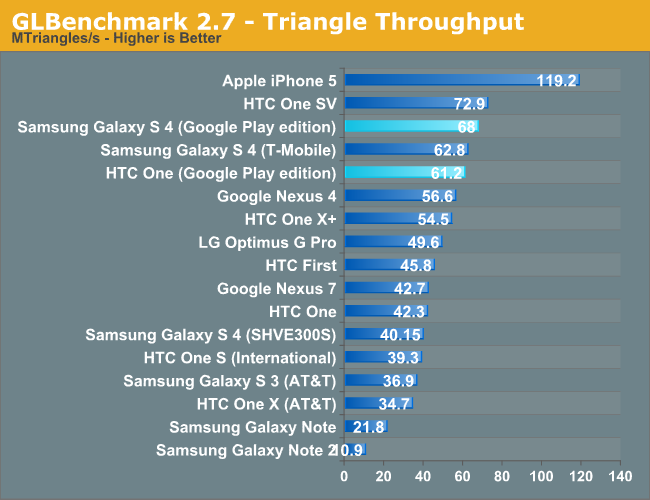
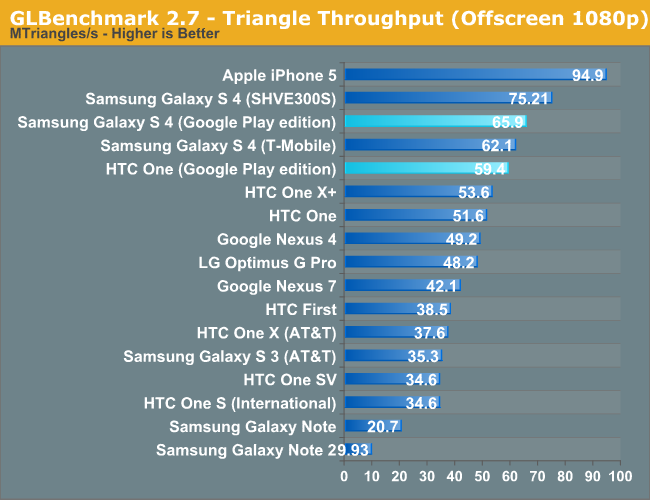
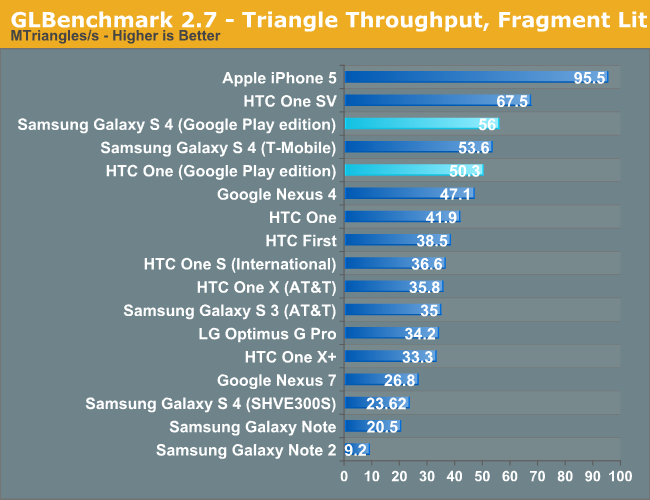
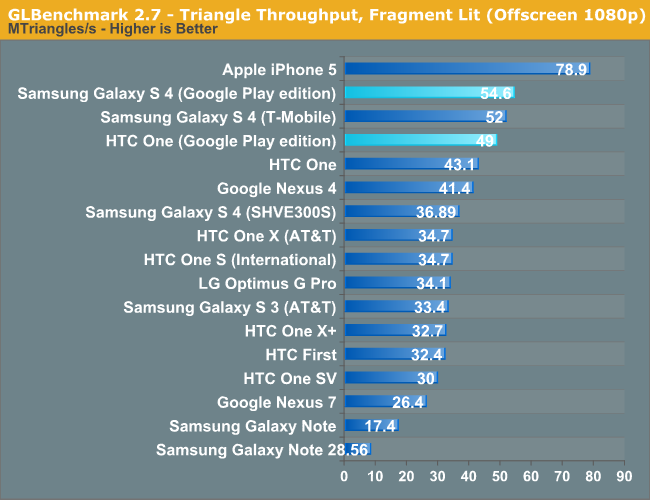


I honestly didn't expect GFXBench to show much of a change at all between the normal and GPe variants of the HTC One and SGS4, and although the T-Rex game simulation test doesn't show much movement, there's an uptick in Egypt HD and a few of the subtests (especially triangle throughput on the HTC One). I suspect newer platform software seriously helps out here, and these improvements will probably carry over to the Sense 5 version with the 4.2.2 update that's coming for it. Still pretty interesting.
Basemark X is a new addition to our mobile GPU benchmark suite. There are no low level tests here, just some game simulation tests run at both onscreen (device resolution) and offscreen (1080p, no vsync) settings. The scene complexity is pretty high, so frame rates are pretty low.
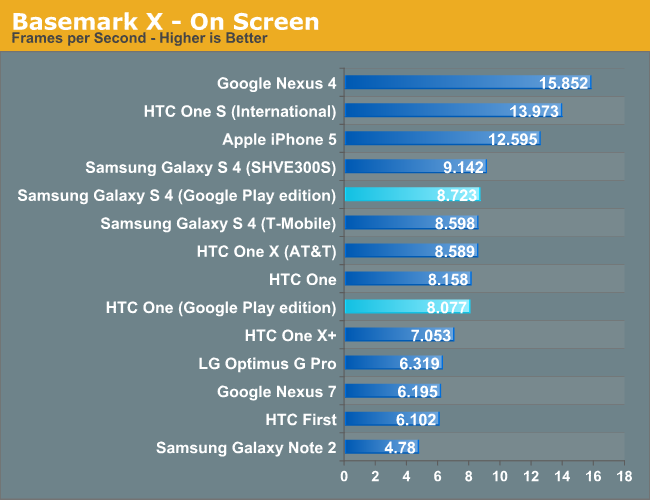
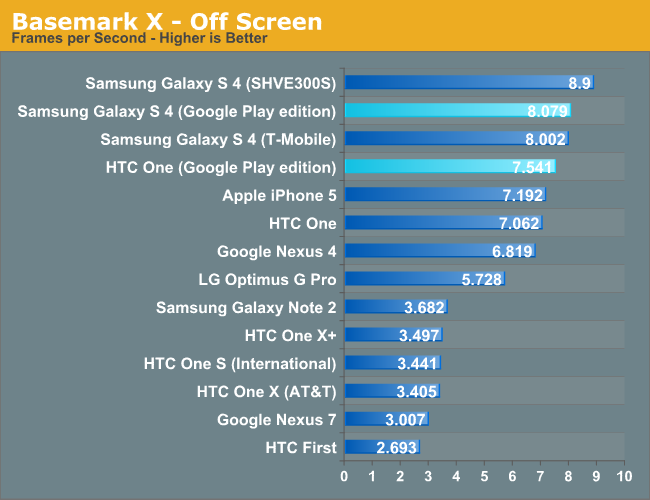
Epic's Citadel benchmark gives us a good indication of lighter workload, v-sync limited performance at native resolution. The new Ultra High Quality test makes this an actual meaningful lighter workload, although there is no easy resolution independence so all these tests run on-screen at device resolution.

Here we also see some gains for both the SGS4 GPe and HTC One GPe over the normal versions. Again it seems that some combination of the newer platform software afforded by this release and AOSP vs skinned software helps these platforms perform a bit better than otherwise they do otherwise.
Battery Life
Battery life testing remains a big concern for everyone; for this we turn to our usual battery life test suite. The basic overview is the same as it has been for a while now — we load webpages at a fixed interval until the handset dies, with display set at exactly 200 nits as always. Power saving features are disabled if they turn on automatically, and background account sync is disabled. The test is performed over both cellular data on all available air interfaces and over WiFi in an environment with good signal levels. The new test has decreased pause time between web page loads and added a number of JavaScript-heavy pages. I sat down with some UMTS RRC (Radio Resource Control) emulator tools and also made sure we had a good balance of all the RRC states (DCH, PCH if possible, FACH, IDLE) so we weren’t heavily biased towards one mode or the other.
I've had both the HTC One GPe and SGS4 GPe for a very limited amount of time, so battery life testing is ongoing and will have to be updated later with the WiFi and call time tests. I have only had time to complete one run of the HTC One GPe on T-Mobile LTE. The result is just narrowly ahead of the Sense 5 HTC One on T-Mobile LTE; I suspect strongly that we'll see the same on the SGS4 GPe on the same network.
Update: I've finished running the SGS4 GPe on T-Mobile LTE, we can see the result crept down slightly but still is in the ballpark of results for the other SGS4s. Also I've included WiFi test results, where oddly enough the results are notably further south of the Sense 5 and TouchWiz counterparts.
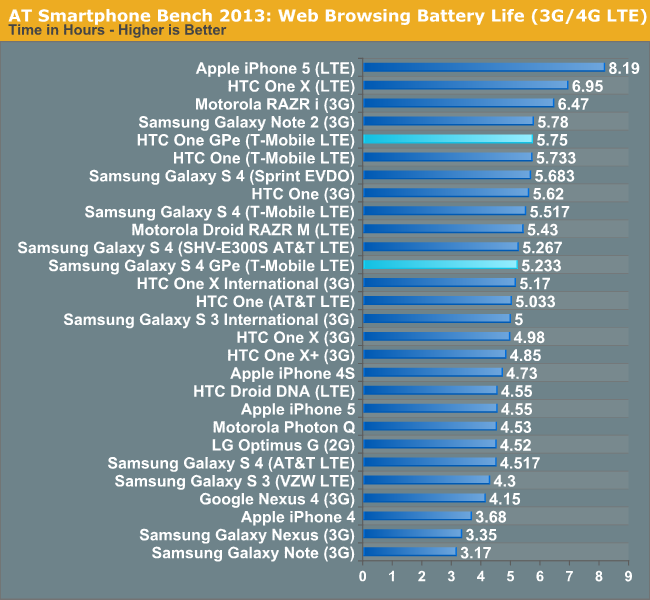

The thing I do miss on the GPe devices are the power saver options which change the CPU governor max CPU frequency and do help make a difference over a day. I haven't measured whether this gets reflected in our battery life test as much as it seems to subjectively, but that's one difference right away you can point to between the normal and GPe versions.










81 Comments
View All Comments
thesavvymage - Thursday, June 27, 2013 - link
its not in stock android, so no it doesnt have it. Assuming you mean for the screenakdj - Thursday, June 27, 2013 - link
Wow...completely off topic, but damn! I can't get rid of my original 'Note' fast enough! Good. Lord! The speed, in every test on these new handsets just absolutely SMOKE the Galaxy Note and GSIII! Unreal...in some case 4-500% increase in performance...still another 6 months to go. Amazing though, the performance increases across the board in just one years time. The Note and GSIII along with the iPhone 4S were really the top of the heap about 13 months back. Now, those numbers are barely enough to 'anchor' your list!That said...pretty amazing how well the iPhone 5 has held up to the newer generation Snapdragon procs. It's still definitely holding its own...even topping the newer hardware in all of those GL/graphic benches. Crazy.
Here's to looking forward to the Note 3 or SG5! Damn two year contracts. This move though by Google will make me second guess my next Android purchase....exactly because of this option. Forget the carrier subsidy. In the two year plan, you're always laying a helluva lot more than the 550-700 dollar range on these Google Play options
I think that may be a third group to add....those of us in America, where the cell companies and their massive monopolous empire they've built on these '2 year' subsidies. Crazy....$600 up front and 40-60 bucks a month vs. a C Note for 24 straight months....that is easily a 50% savings on the initial purchase.
qucktaker - Thursday, June 27, 2013 - link
Can I assume that the Samsung SAFE APIs will not be included in the Galaxy S4 Google Play Edition?MrDarthBuddy - Thursday, June 27, 2013 - link
Are you going to benchmark that Radeon card too? LOLcbutters - Thursday, June 27, 2013 - link
What about wifi calling?cyberguyz - Thursday, June 27, 2013 - link
Samsung includes exFAT to support SD cards >32GB under license with Microsoft.Because raw Android does not license this from Microsoft, can it provide the same SDCard support that Samsung does? I am doubting it - hence only half-assed support for >32GB SDCards.
augustofretes - Thursday, June 27, 2013 - link
I wouldn't worry too much about the crappy camera, or a missing application, I'm sure there's going to be a perfectly functional ROM that will simply bring the HTC's or Samsung's framework to an otherwise AOSP ROM to run the camera app, etc.xaml - Thursday, June 27, 2013 - link
"I've had a lot success handing out Nexus 4 phones"You wouldn't mind, now, would you? ;-)
nubian1 - Friday, June 28, 2013 - link
My concern is that the kernel is still being supplied by the respective manufacturers with Google only supplying the Stock Android OS. This can still lead to lack of ongoing support as newer handsets come out from HTC & Samsung. I'm not convinced.bamyasi - Saturday, June 29, 2013 - link
Contrary to what Brian wrote in his review, GS4 GPE is an AT&T variant and its radio does not include WCDMA Band IV (AWS), so T-Mobile HSPA+ will not work on this phone. Oh, and GP phone page clearly states this (under Tech Specs).